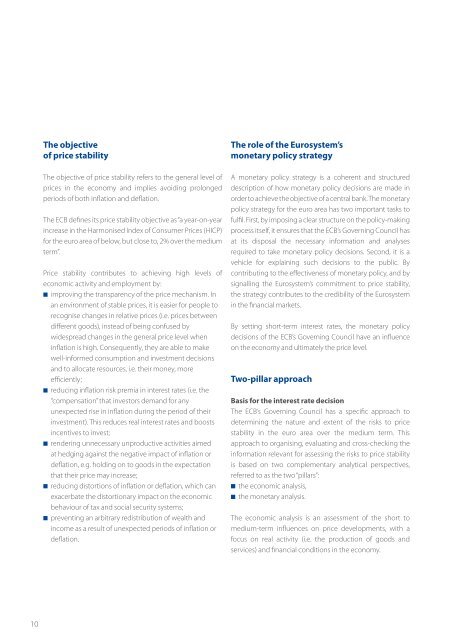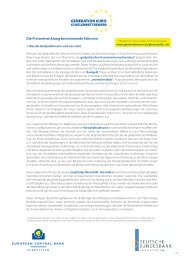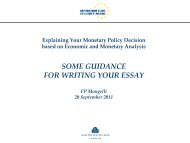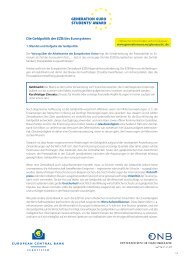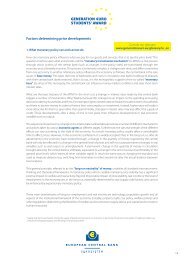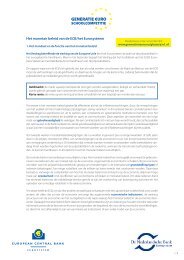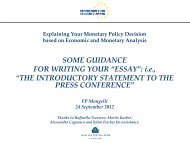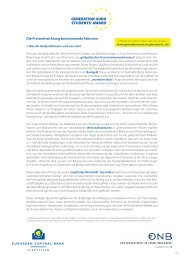Teacher's booklet - the Generation ?uro Students' Award
Teacher's booklet - the Generation ?uro Students' Award
Teacher's booklet - the Generation ?uro Students' Award
You also want an ePaper? Increase the reach of your titles
YUMPU automatically turns print PDFs into web optimized ePapers that Google loves.
The objective<br />
of price stability<br />
The objective of price stability refers to <strong>the</strong> general level of<br />
prices in <strong>the</strong> economy and implies avoiding prolonged<br />
periods of both inflation and deflation.<br />
The ECB defines its price stability objective as “a year-on-year<br />
increase in <strong>the</strong> Harmonised Index of Consumer Prices (HICP)<br />
for <strong>the</strong> e<strong>uro</strong> area of below, but close to, 2% over <strong>the</strong> medium<br />
term”.<br />
Price stability contributes to achieving high levels of<br />
economic activity and employment by:<br />
■■<br />
improving <strong>the</strong> transparency of <strong>the</strong> price mechanism. In<br />
an environment of stable prices, it is easier for people to<br />
recognise changes in relative prices (i.e. prices between<br />
different goods), instead of being confused by<br />
widespread changes in <strong>the</strong> general price level when<br />
inflation is high. Consequently, <strong>the</strong>y are able to make<br />
well-informed consumption and investment decisions<br />
and to allocate resources, i.e. <strong>the</strong>ir money, more<br />
efficiently;<br />
■■<br />
reducing inflation risk premia in interest rates (i.e. <strong>the</strong><br />
“compensation” that investors demand for any<br />
unexpected rise in inflation during <strong>the</strong> period of <strong>the</strong>ir<br />
investment). This reduces real interest rates and boosts<br />
incentives to invest;<br />
■■<br />
rendering unnecessary unproductive activities aimed<br />
at hedging against <strong>the</strong> negative impact of inflation or<br />
deflation, e.g. holding on to goods in <strong>the</strong> expectation<br />
that <strong>the</strong>ir price may increase;<br />
■■<br />
reducing distortions of inflation or deflation, which can<br />
exacerbate <strong>the</strong> distortionary impact on <strong>the</strong> economic<br />
behaviour of tax and social security systems;<br />
■■<br />
preventing an arbitrary redistribution of wealth and<br />
income as a result of unexpected periods of inflation or<br />
deflation.<br />
The role of <strong>the</strong> E<strong>uro</strong>system’s<br />
monetary policy strategy<br />
A monetary policy strategy is a coherent and structured<br />
description of how monetary policy decisions are made in<br />
order to achieve <strong>the</strong> objective of a central bank. The monetary<br />
policy strategy for <strong>the</strong> e<strong>uro</strong> area has two important tasks to<br />
fulfil. First, by imposing a clear structure on <strong>the</strong> policy-making<br />
process itself, it ensures that <strong>the</strong> ECB’s Governing Council has<br />
at its disposal <strong>the</strong> necessary information and analyses<br />
required to take monetary policy decisions. Second, it is a<br />
vehicle for explaining such decisions to <strong>the</strong> public. By<br />
contributing to <strong>the</strong> effectiveness of monetary policy, and by<br />
signalling <strong>the</strong> E<strong>uro</strong>system’s commitment to price stability,<br />
<strong>the</strong> strategy contributes to <strong>the</strong> credibility of <strong>the</strong> E<strong>uro</strong>system<br />
in <strong>the</strong> financial markets.<br />
By setting short-term interest rates, <strong>the</strong> monetary policy<br />
decisions of <strong>the</strong> ECB’s Governing Council have an influence<br />
on <strong>the</strong> economy and ultimately <strong>the</strong> price level.<br />
Two-pillar approach<br />
Basis for <strong>the</strong> interest rate decision<br />
The ECB’s Governing Council has a specific approach to<br />
determining <strong>the</strong> nature and extent of <strong>the</strong> risks to price<br />
stability in <strong>the</strong> e<strong>uro</strong> area over <strong>the</strong> medium term. This<br />
approach to organising, evaluating and cross-checking <strong>the</strong><br />
information relevant for assessing <strong>the</strong> risks to price stability<br />
is based on two complementary analytical perspectives,<br />
referred to as <strong>the</strong> two “pillars”:<br />
■■<br />
<strong>the</strong> economic analysis,<br />
■■<br />
<strong>the</strong> monetary analysis.<br />
The economic analysis is an assessment of <strong>the</strong> short to<br />
medium-term influences on price developments, with a<br />
focus on real activity (i.e. <strong>the</strong> production of goods and<br />
services) and financial conditions in <strong>the</strong> economy.<br />
It takes account of <strong>the</strong> fact that price developments over<br />
those horizons are influenced largely by <strong>the</strong> interplay of<br />
supply and demand in <strong>the</strong> goods, services and factor markets<br />
(e.g. factors of production such as labour, capital and land).<br />
The monetary analysis focuses on <strong>the</strong> longer term, and draws<br />
on <strong>the</strong> long-run link between money and prices. It serves<br />
mainly as a means of cross-checking, from a medium to<br />
long-term perspective, <strong>the</strong> short to medium-term indications<br />
for monetary policy stemming from <strong>the</strong> economic analysis.<br />
The two-pillar approach is designed to ensure that no<br />
relevant information is overlooked in <strong>the</strong> assessment of risks<br />
to price stability and that sufficient attention is paid to<br />
different perspectives and <strong>the</strong> cross-checking of information<br />
in order to come to an overall judgement on <strong>the</strong> risks to price<br />
stability. It represents a diversified analysis and ensures robust<br />
decision-making.<br />
Monetary policy instruments<br />
Monetary policy operates by steering short-term interest<br />
rates, <strong>the</strong>reby influencing economic developments in <strong>the</strong><br />
best possible way. The steering of short-term interest rates<br />
is carried out through <strong>the</strong> operational implementation of<br />
monetary policy. To this end, <strong>the</strong> E<strong>uro</strong>system has at its<br />
disposal a set of monetary policy instruments, namely open<br />
market operations, standing facilities and minimum reserves.<br />
A: Open market operations<br />
The most important monetary policy instrument is <strong>the</strong> open<br />
market operation, which serves to:<br />
■■<br />
steer interest rates;<br />
■■<br />
manage <strong>the</strong> liquidity situation in <strong>the</strong> money market;<br />
■■<br />
signal <strong>the</strong> monetary policy stance.<br />
Open market operations can be divided into <strong>the</strong> following<br />
four categories:<br />
■■<br />
main refinancing operations, which are regular liquidityproviding<br />
reverse transactions with a weekly frequency<br />
and a maturity of one week;<br />
■■<br />
longer-term refinancing operations, which are liquidityproviding<br />
reverse transactions with a monthly frequency<br />
and a maturity of three months;<br />
■■<br />
fine-tuning operations, which are executed on an ad hoc<br />
basis and are aimed at managing <strong>the</strong> liquidity situation<br />
in <strong>the</strong> market and steering interest rates, in particular<br />
to smooth <strong>the</strong> effects on interest rates of unexpected<br />
fluctuations in market liquidity;<br />
■■<br />
structural operations, which are carried out through <strong>the</strong><br />
issuance of debt certificates, reverse transactions and<br />
outright transactions.<br />
B: Standing facilities<br />
The E<strong>uro</strong>system also offers standing facilities, which aim<br />
to provide and absorb overnight liquidity and set <strong>the</strong><br />
boundaries for overnight market interest rates:<br />
The two standing facilities are:<br />
■■<br />
<strong>the</strong> marginal lending facility, which allows counterparties<br />
(i.e. financial institutions such as banks) to obtain<br />
overnight liquidity from <strong>the</strong> e<strong>uro</strong> area national central<br />
banks against eligible assets;<br />
■■<br />
<strong>the</strong> deposit facility, which can be used by counterparties<br />
to make overnight deposits with <strong>the</strong> e<strong>uro</strong> area national<br />
central banks.<br />
C: Minimum reserves<br />
Finally, <strong>the</strong> E<strong>uro</strong>system requires credit institutions to hold<br />
minimum reserves on accounts with <strong>the</strong> e<strong>uro</strong> area national<br />
central banks. The purpose of <strong>the</strong> minimum reserve system<br />
is to stabilise money market interest rates and to create or<br />
enlarge a structural liquidity shortage.<br />
10<br />
11


